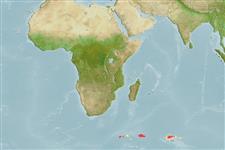Élasmobranches (requins et raies) (sharks and rays) >
Rajiformes (Skates and rays) >
Rajidae (Skates)
Etymology: Amblyraja: Greek, amblys = darkness + Latin, raja, -ae = ray (Raja sp.) (Ref. 45335).
Eponymy: This is a form of toponym rather than an eponym: TAAF = Territoire des Terres australes et antarctiques françaises (French Southern and Antarctic Territories). (Ref. 128868), visit book page.
Issue
Possibly a junior synonym of A. hyperborea due to strong morphological similarity according to Ebert & Stehmann (2013, Ref. 98315) and Weigmann (2016, Ref. 118749) (Ref. 118749).
Environment: milieu / climate zone / depth range / distribution range
Écologie
marin bathydémersal; profondeur 150 - 600 m (Ref. 114953), usually 375 - 390 m (Ref. 58018). Polar; 35°S - 49°S, 180°W - 180°E
Southeastern Atlantic: South Africa (Compagno et al. in Ebert et al. 2009 but see Ref. 114953); Indian Ocean: Crozet I. (Ref. 45488). Subantarctic: Widespread.
Taille / Poids / Âge
Maturity: Lm ? range ? - ? cm
Max length : 90.0 cm TL mâle / non sexé; (Ref. 114953)
Found on insular shelves and slopes. Mainly feeds on benthic invertebrates and bony fishes (Ref. 114953). Oviparous (Ref. 50449). Eggs have horn-like projections on the shell (Ref. 205). Young hatches at ca. 17 cm TL (Ref. 114953).
Life cycle and mating behavior
Maturité | Reproduction | Frai | Œufs | Fécondité | Larves
Oviparous, paired eggs are laid. Embryos feed solely on yolk (Ref. 50449). Eggs have horn-like projections on the shell (Ref. 205).
McEachran, J.D. and K.A. Dunn, 1998. Phylogenetic analysis of skates, a morphologically conservative clade of elasmobranchs (Chondrichthyes: Rajidae). Copeia 1998(2):271-290. (Ref. 27314)
Statut dans la liste rouge de l'IUCN (Ref. 130435: Version 2024-1)
Menace pour l'homme
Harmless
Utilisations par l'homme
Pêcheries: pêcheries vivrières
Outils
Articles particuliers
Télécharger en XML
Sources Internet
Estimates based on models
Preferred temperature (Ref.
123201): 1.4 - 2.3, mean 2 °C (based on 27 cells).
Phylogenetic diversity index (Ref.
82804): PD
50 = 0.5010 [Uniqueness, from 0.5 = low to 2.0 = high].
Bayesian length-weight: a=0.00302 (0.00141 - 0.00645), b=3.24 (3.07 - 3.41), in cm total length, based on LWR estimates for this (Sub)family-body shape (Ref.
93245).
Niveau trophique (Ref.
69278): 4.2 ±0.3 se; based on size and trophs of closest relatives
Résilience (Ref.
120179): Faible, temps minimum de doublement de population : 4,5 à 14 années (Fec assumed to be <100).
Fishing Vulnerability (Ref.
59153): High vulnerability (56 of 100).
Climate Vulnerability (Ref.
125649): Very high vulnerability (100 of 100).
